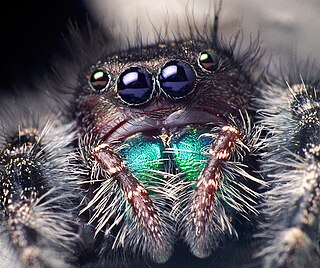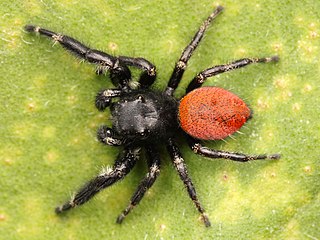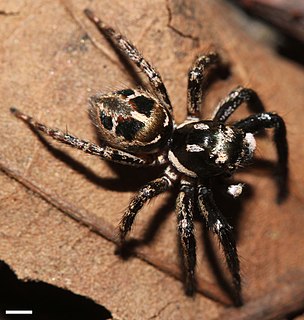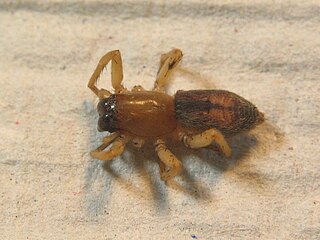
The spider family Liphistiidae, recognized by Tamerlan Thorell in 1869, comprises 8 genera and about 100 species of medium-sized spiders from Southeast Asia, China, and Japan. They are among the most basal living spiders, belonging to the suborder Mesothelae. In Japan, the Kimura spider is well known.
Button spider is a common name used in Southern Africa to refer to local members of the spider genus, Latrodectus, the family Theridiidae. There are both black and brown button spiders in Southern Africa, that are known elsewhere as widow spiders. Seven Latrodectus species can be found in Southern Africa; six of them are native, one is possibly imported.

Phidippus is a genus in the family Salticidae. Some of the largest jumping spiders inhabit this genus, and many species are characterized by their brilliant, iridescent green chelicerae. Phidippus is distributed almost exclusively in North America, with the exception of two exported species. As of January 2021, there were about 80 described species in the genus. Species previously described in Phidippus which are found in India and Bangladesh do not belong in this genus.

Bagheera is a genus of jumping spiders within the family Salticidae, subfamily Salticinae and subtribe Dendryphantina. The genus was first described by George Peckham & Elizabeth Peckham in 1896. The name is derived from Bagheera, a character from Rudyard Kipling's Jungle Book.

Hentzia is a genus of the spider family Salticidae subfamily Dendryphantinae. The genus is widespread in North America and northern South America but the center of biodiversity seems to be primarily in the Caribbean and surrounding areas, with the greatest species diversity occurring in Cuba, which has seven species. Some outlier species, such as Hentzia poenitens and Hentzia fimbriata are found in western North America. It appears to be closely related to the genus Anicius from which it differs primarily in certain anatomical details.

Zygoballus is a genus of jumping spiders found in North and South America.

Phidippus johnsoni, the red-backed jumping spider, is one of the largest and most commonly encountered jumping spiders of western North America. It is not to be confused with the unrelated and highly venomous redback spider.

Phidippus californicus is a species of jumping spider. It is found in the southwestern United States and northern Mexico.

The Dendryphantina are a subtribe of jumping spiders that occur mainly in the New World. The subtribe was first defined by Anton Menge in 1879 as Dendryphantidae. Females of the subtribe generally show paired spots on the abdomen, and the males often have enlarged chelicerae. Females in this subtribe typically have S-shaped epigynal openings.
Euophrys bulbus is a species of jumping spiders found only in Taiwan. This is a very small spider with a total length of just over 3 mm. The sparsely hairy carapace is dark brown with black margins and a black w-shaped mark about halfway along the back. The legs are dark brown with greyish-black markings. The roughly cylindrical abdomen is marked generally with short blackish lines with three pairs of light depressions along the back with further light markings, a crescent flanked by diagonal lines, towards the rear.

Tarantulas comprise a group of large and often ″hairy″ spiders of the family Theraphosidae. Currently, about 1,000 species have been identified. The term tarantula is usually used to describe members of the family Theraphosidae, although many other members of the same infraorder (Mygalomorphae) are commonly referred to as "tarantulas" or "false tarantulas". Some of the more common species have become popular in the exotic pet trade. Many New World species kept as pets have urticating hairs that can cause irritation to the skin, and in extreme cases, cause damage to the eyes.

Bagheera kiplingi is a species of jumping spider found in Central America, including Mexico, Costa Rica, and Guatemala. It is the type species of the genus Bagheera, which includes three other species, including B. prosper. B. kiplingi is notable for its peculiar diet, which is mostly herbivorous. No other known species of omnivorous spider has such a markedly herbivorous diet.

Zygoballus sexpunctatus is a species of jumping spider which occurs in the southeastern United States where it can be found in a variety of grassy habitats. Adult spiders measure between 3 and 4.5 mm in length. The cephalothorax and abdomen are bronze to black in color, with reddish brown or yellowish legs. The male has distinctive enlarged chelicerae and front femora. Like many jumping spiders, Z. sexpunctatus males exhibit ritualized courtship and agonistic behavior.

Anasaitis canosa, previously of the genus Corythalia, is a small jumping spider that can typically be found atop leaf-litter or man-made structures such as fences and exterior walls. This species is more commonly known as the twin-flagged jumping spider due to the two pennant shaped markings on the dorsal side of the cephalothorax. Typical of the genus Anasaitis, this species has iridescent setae ("scales") which may appear white, green or pink which create the "flags" as well as patches on the male pedipalps used in courtship and intraspecific signaling. This species is roughly 5 to 6 mm in length. A. canosa ranges from Mexico to South Carolina along the Gulf of Mexico.

Aphonopelma marxi is a species of spider in the family Theraphosidae (tarantulas), found in United States. Aphonopelma behlei and A. vogelae, at one time considered separate species, are now considered to be synonyms.

Pachistopelma rufonigrum is a species of theraphosid, contained within the Aviculariinae subfamily. It is endemic to Brazil.

Euryattus bleekeri, known as Bleeker's jumping spider, is a species of spider in the family Salticidae. It is found from Sri Lanka to Queensland.

Clubiona subsultans, the Caledonian sac spider, is a spider from the family Clubionidae with a Palearctic distribution.

Tetragnatha montana, commonly known as the silver stretch spider, is a species of long-jawed orb weaver from the family Tetragnathidae that has a Palearctic distribution. It preys mostly on flies and mosquitoes. The name silver stretch spider refers to its shiny metallic colour and its habit of extending its legs into a stick like shape.

Leucauge mariana is a long-jawed orb weaver spider, native to Central America and South America. Its web building and sexual behavior have been studied extensively. Males perform several kinds courtship behavior to induce females to copulate and to use their sperm.

















